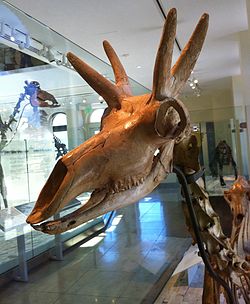| Stockoceros Temporal range: | |
|---|---|
 | |
| S. conklingi skeleton | |
 | |
| Life restoration | |
| Scientific classification | |
| Kingdom: | Animalia |
| Phylum: | Chordata |
| Class: | Mammalia |
| Order: | Artiodactyla |
| Family: | Antilocapridae |
| Tribe: | † Stockoceratini |
| Genus: | † Stockoceros Skinner, 1942 |
| Species | |
Stockoceros is an extinct genus of the North American artiodactyl family Antilocapridae (pronghorns), [2] one known to have inhabited what is now Mexico and the Southwestern United States during the Pleistocene epoch. [1] The genus survived until about 12,000 years ago, and was present when Paleo-Indians arrived in North America from Eurasia. [3] [4]
